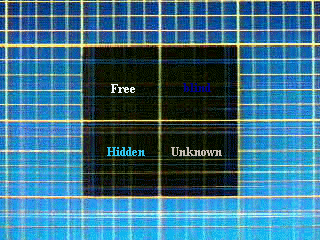Until now you have utilized self-perception theory [1] and focused on becoming aware of yourself. Sometimes you may lack awareness of yourself and wish to compare your perceptions with others in order to increase your awareness.
"Other" perception theory, or the social comparison theory, has been noted in research and can be utilized by us to learn more about our attitudes and emotions by comparing them with others. A word of caution, however, is that other's interpretations of us should be accepted only as information from which to compare how we may have learned to respond to situations.

The Johari window serves as illustration as to how our awareness may be free, blind, hidden, or unknown. [2] The concept illustrates the different levels of awareness. As a relationship continues the tendency increases the free area of the window and reduces the blind and hidden area. Through a process of self-disclosure, you may increase your self- awareness. [3]
![]() Click
your mouse pointer on the hyperlink below in order to review more
information regarding the Johari Window.
http://www.noogenesis.com/game_theory/johari/johari_window.html,
Click
your mouse pointer on the hyperlink below in order to review more
information regarding the Johari Window.
http://www.noogenesis.com/game_theory/johari/johari_window.html,
The free window pane of the Johari window refers to information that is readily available to one's self and others.
The blind window pane refers to information that is not known to one's self but is known to others.
The hidden window pane refers to information that is known to one's self, but is not known to others.
The unknown window pane refers to information that is not known to oneself nor to others.
When you, or others, disclose how you are reacting to them, or they to you, the process is called feedback. Feedback that others give may increase our self-awareness, i.e., provided that the feedback is focused on the here and now, is specific, and is descriptive. Giving and receiving feedback requires considerable skill and should not be given as a release of tension by the giver. The appropriate guidelines for self disclosure are as follows:
1. Focus feedback on the person's behavior,
2. Be descriptive and not judgmental,
3. Focus behavior on a specific situation,
4. Focus feedback on the " here and now,"
5. Share your perceptions and feelings and do not give advice. [3]
Assignment:
![]() Answer
the following questions and send the answer to your instructor.
Answer
the following questions and send the answer to your instructor.
1.Could you tell what might be projection , i. e, interpretation on your friend's part?
2. How would you know?
3. What did you learn from this Johari exercise?
![]()
You can compare the information with the 16PF to see what you may discover about your unknown.
1. David Johnson Reaching Out 10th ed.( Boston, London, Toronto, Sydney, Tokyo, Singapore: Allyn and Bacon 2003) pages 58-62.
2. Ibid., p. 58
3.Ibid, p. 60
3. Duen Hsi Yen, http://www.noogenesis.com/game_theory/johari/johari_window.html, (Permission granted July 7, 2003.)
l rbrehm@msn.com Telephone: Cell 206-930-4197.
Copyright © 1998 [Robert Brehm]. All rights reserved.